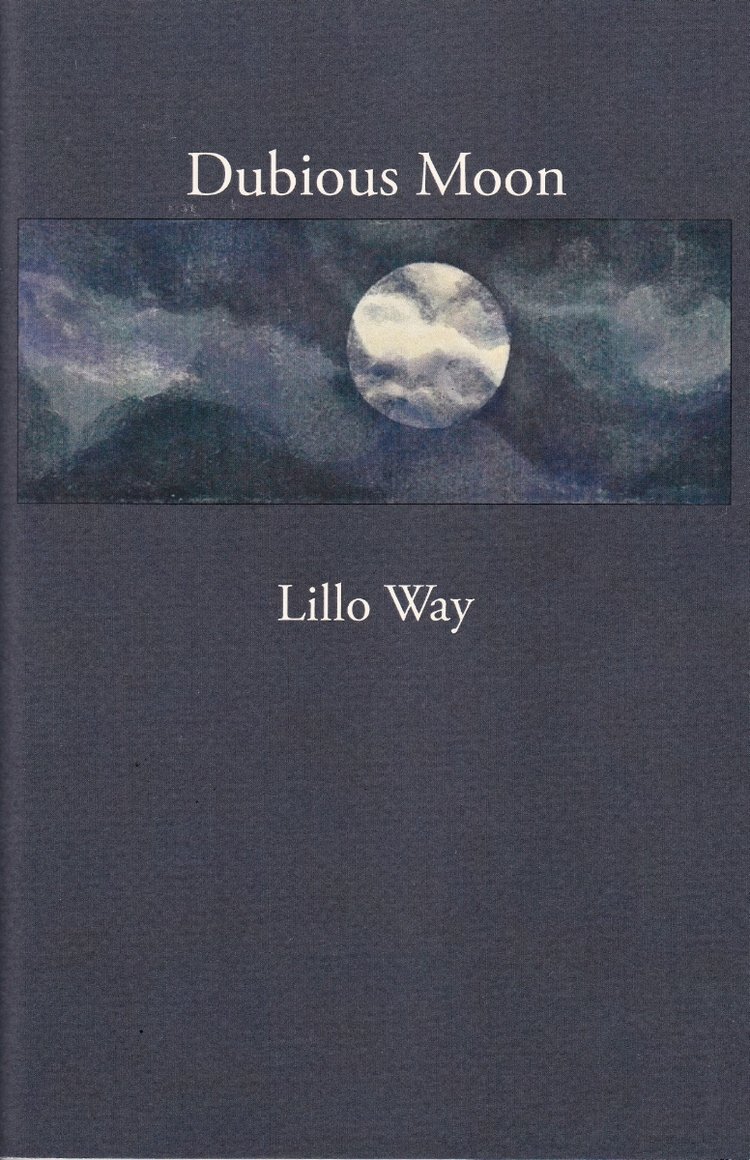Life Being Lived
Dubious Moon by Lillo Way
A 2017 Hudson Valley Writers Center’s Slapering Hol Chapbook Contest Winner
Reviewed by Abby Feden
Nestled between two prints of fully faced moons, the poems within Lillo Way’s chapbook Dubious Moon appear to the reader as cosmic bodies themselves—filled with incandescent language and imagery. Way presents works of quiet beauty that invoke questions, curiosity, and wonder. The poems are an exploration of intimacy, tracking the moon and its dubious progression through the heavens, and feature “lunatics” guiding our narrator in and out of dreams.
Within Way’s work, the exploration of experience permits the reader to become intimate with the narrator—night to night, moon to moon. We live alongside her in her kitchen, her bed, within her ruminations and her dreams. The reader is permitted to observe quiet spaces of vulnerability, for instance, in “sleepwalker” we observe Way’s persona tend to the restless sleeping of a loved one:
you never see me your fingerprints
oil no walls your knees
slip by chairs no curtains
brush your flannels you steer clear
we might be ballroom dancers
Woven through Way’s poems are moments like this; she presents a seemingly innocuous life occurrence and teaches us to see the singular beauty within it. The sleepwalker’s unconscious care of the home, the narrator’s soft touch guiding her loved-one back to bed: “your palm rests in my left / gently I place my right on your waist.” Way’s capturing of these occurrences and the allowance of the reader to share in their private tenderness’ is one facet of the many that make this collection so poignant. We are offered naked emotion and shown how to emulate it in our own lives.
We are also shown the extent of Way’s radiant talent: Dubious Moon is a collection of striking images and transcendent language, each line demanding to be read again so that we might recapture the joy we felt upon first encountering it. Our introduction to Way’s collection is “Frame the Moon,” a poem that flourishes lovely upon the page, and indicates to us that we have come across something extraordinary:
my quarter-revolving eye catches
a perfectly sliced-in-half moon centered
in the upper right corner of the upper
left pane of a window blued by a sky
somewhere between baby-boy daytime
and electric-transvestite midnight—
the perfect globe cleavered by
a celestial butcher-boy—
Each image is made clear in the reader’s mind, vivid diction-strokes creating for us an illustration of our narrator’s experiences. It is fitting that an ekphrastic should be included in this work, a poem entitled “1955 Rauschenberg Bed” and entwining a narratorial vulnerability with the beauty of Way’s language. In this poem, Robert Rauschenberg’s artwork is called forth and unmade, becoming a bed of life lived instead: “last night your hair fell out/and scribbled all over the pillow” and “Down the covers slide mucus/blood and moonrays in a bedhead afterbirth.”. In my reading, I found this poem to be the most emblematic of the themes at work within the collection. Way is capturing life, thoughtfully exploring its glories. The strength of this collection comes from Way’s unwavering acknowledgment of the aspects of life we fear, and her ability to still find within them humor, hope, and most importantly, meaning.
In “Dubious Moon,” our narrator admits her eyesight is failing, but no matter:
Some people claim they’ve never seen the moon
perfectly full. But I’ve caught it that way
countless times, like tonight. Those of us
with poor eyesight are the beneficiaries
of such gifts. Without my glasses, I see seven
overlapping—an embarrassment of moons.
It is not a denial of the narrator’s reality, nor is it a dismissal of loss or grief, but instead an impartation of Way’s insight—adaptation, becoming comfortable with subjects we often attempt to ignore or soften. The final stanzas of “1955 Rauschenberg Bed” state “What a life we’ve slept here—hair/blood, and sun in the sheep-blinking earth” and instill within the reader this wisdom: life, every phase of it, deserves celebration.
Lastly, to reckon with the looming moon, our constant companion throughout Way’s work—why is she here, what does she mean? The moon makes itself present in each poem, the “perfectly sliced-in-half” moon, the “two-thirds of a disc with a scissored upper side” moon, the “dubious” moon, and at times acts as a guide, a partner, or a source of consternation. Repeatedly, Way brings the moon into moments where the narrator greets adaptation, reflects upon the changes life has brought her: “will you whisper in my ears/the few things I need to remember?” We follow the lunar phases as we follow the stages of our narrator’s life, the cosmic light illuminating aspects of life’s uncertainties we cannot control, we cannot foresee. From this, Way draws forth that uncertainty, that dubious progression forward, acknowledges the fear it elicits and instead chooses to focus upon “the first half of hope, not the last.”
Lillo Way’s Dubious Moon is a study of life, the tumultuous lows, joyous highs, a celebration of individual moments. Way’s poems circle in on the exploration of vulnerability, the accumulation of experiences that we have been taught to dread, or to hide: aging, loss, grief. This collection of celestial images does not pass over these complexities of life, but instead acknowledges such moments as significations of life being lived.
Abby Feden is a writer hailing from the Great Plains of Nebraska. She is currently a graduate student in Western Washington University’s MFA Program.
Featured image titled “Fisherman on Venice Pier taking a photograph of the Supermoon blue blood moon with partial lunar eclipse, Venice, Florida” by Diana Robinson
